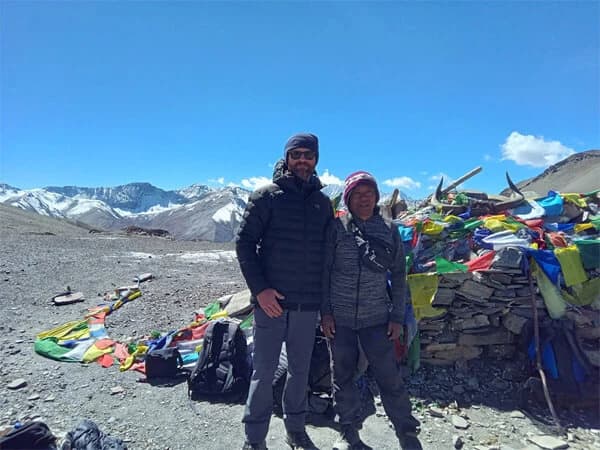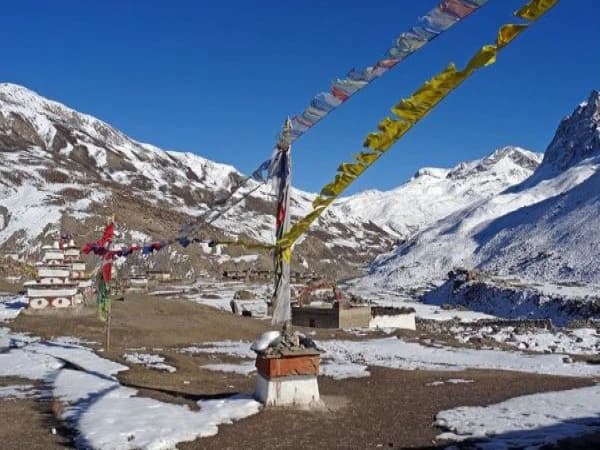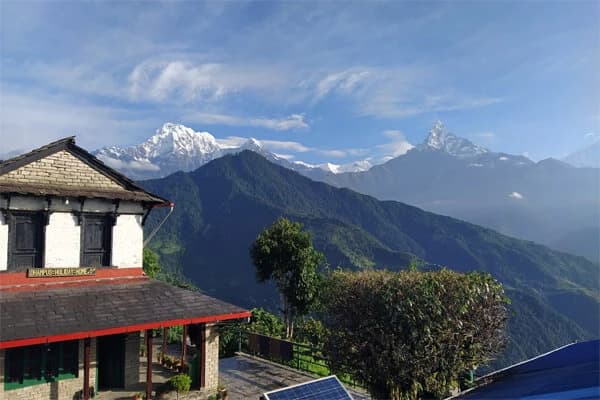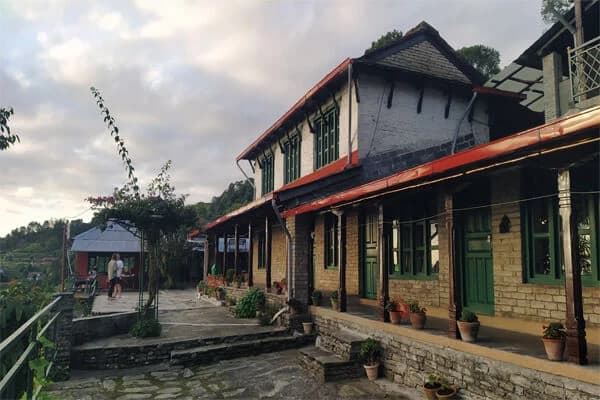Every trekker should be aware of theLower Dolpo Trek difficulty before entering this isolated and stunning region of western Nepal. High mountain passes, untamed landscapes, and culturally vibrant villages that seem unaffected by modern life are all part of the journey. The travel is difficult even though the scenery is stunning. There are places that cross rivers or traverse rough terrain, and the pathways can be dusty, rocky, and steep. Additionally, trekkers must contend with high altitudes passes that can reach almost 5,000 meters which, if not properly treated, can result in altitude sickness.
The distance creates additional difficulties because there are few amenities, few food alternatives, and frequently no communication. Camping is required for the majority of the trek, which necessitates using porters or packing extra equipment. With frigid nights and strong gusts at higher elevations, the weather can also change rapidly. To appreciate this adventure, you must be well-prepared, mentally strong, and physically active.
This blog seeks to provide you with a thorough understanding of the challenges of the Lower Dolpo Trek so that you can mentally and physically prepare. You will know exactly what to anticipate at the finish, as well as whether this route fits your experience and adventure objectives.
Overall Difficulty Level for Lower Dolpo Trek
A moderate to difficult trek, the Lower Dolpo trek is well-known. This indicates that while it is not the most difficulttrek in Nepal, it is not the easiest either. Long trekking days, high mountains, and being far from contemporary amenities are all things you should prepare for. The trek passes through isolated regions with few people, no highways, and no large cities. This makes the trip serene and lovely, but it also means you need to be ready.
The trek is difficult in large part because of its remoteness. Lower Dolpo is located in Nepal's far west. Just getting to the trek's beginning takes a few days. You will be far from cities, large stores, and hospitals once you begin walking. You can not simply buy it on the road if you fail to pack something essential.
The altitude is another factor. The trek crosses steep mountain passes that are about 5,000 meters above sea level in some places. Because there is less oxygen in the air at this altitude, you could get weary more easily. Walking slowly will allow your body to acclimate to the thin air. Altitude sickness can be dangerous for people who do not get enough sleep.
Long walking hours are another aspect of the expedition. You might trek up high slopes or down rough trails for six to eight hours on certain days. Stones, sludge, or loose soil are common features of the rugged terrain. This calls for strong legs and feet as well as supportive, comfortable footwear.
The trek may possibly be more difficult due to the weather. Snow may cover high passes during the colder months, making them slick. Crossings might be challenging during the wet season due to muddy pathways and swollen creeks.
The Lower Dolpo Trekking is not just for experienced trekkers, despite its difficulty. You can appreciate it if you are prepared, healthy, and dedicated. Numerous trekkers claim that the breathtaking scenery, hospitable locals, and sense of adventure make the effort worthwhile.
This trek is ideal for those who want a challenge and wish to see some of Nepal's most remote and breathtaking areas. But before you leave, it is crucial to be mentally and physically prepared.
Terrain and Trail Conditions During the Lower Dolpo Trek
The Lower Dolpo Trek passes across a variety of terrain and trails. While some sections are rough, steep, and difficult to walk on, others are pleasant and smooth. You can prepare and enjoy the trip more if you know what the trails are like.
Rugged and Rocky Paths
Rough, uneven terrain makes up a large portion of the Lower Dolpo Hiking path. You will frequently be walking over rocky terrain, which can be taxing on your legs and feet. You must be careful where you go because the trail occasionally crosses dry riverbeds or loose stones. Strong-grip trekking shoes are crucial in this situation. Additionally, walking poles can cushion your knees and help you maintain your balance. These routes can be exhausting, but they also pass by crystal-clear rivers and through picturesque landscapes.
Steep Climbs and Descents
There are a lot of ups and downs during the trek. On certain days, it will take you hours to ascend to a high mountain pass. On other days, you will descend into deep valleys on steep slopes. Because of the thin air at higher elevations, climbing can be slow, and descending can be taxing on the knees. Walking slowly, taking stops, and conserving energy are all crucial. The effort is worthwhile despite the difficulty of the climbs because they frequently result in breathtaking views of snow-covered peaks and vibrant surroundings.
High Mountain Passes and River Crossings
Crossing steep mountain passes, some of which are over 5,000 meters, is one of the Upper Dolpo Trek most difficult obstacles. In some seasons, these passes may experience snowfall and wind. Because of the limited and sometimes exposed routes, you should exercise caution and listen to your guide's advise. In lower regions, you might need to use stepping stones or tiny wooden bridges to cross rivers. These crossings can be challenging, particularly after rain if the water level is high. After such crossings, wearing waterproof shoes and dry socks might help you stay comfortable.
The Lower Dolpo Trek terrain is stunning but challenging. Along with calm valleys and untamed, wild environment, you will encounter rocky paths, high passes, and hard climbs. These trail conditions can become an asset rather than an issue if you have the proper equipment, keep a steady pace, and have an optimistic outlook.
Altitude and Acclimatization
You will trek across high alpine regions on the Lower Dolpo Trek. Particularly while traversing the large mountain passes, there are sections of the trek that are above 5,000 meters above sea level. Compared to most people, this is significantly higher. There is less oxygen to breathe at these altitudes because the air is thinner. You might observe that you tire more easily and that walking uphill feels more difficult. The high altitude can nevertheless have an impact on your body, even if you are physically robust and fit. Because of this, it is crucial to walk gently and allow your body to acclimate to the height.
Common Altitude Problems
Altitude sickness can occur when people travel to high altitudes too rapidly. This occurs as a result of the body receiving insufficient oxygen. Headache, nausea, lightheadedness, appetite loss, or difficulty falling asleep are typical symptoms. Altitude sickness can be hazardous in severe cases, necessitating an emergency descent to a lower location. You must exercise caution because the Lower Dolpo Trekking includes some days with strenuous climbing. Taking your time and paying attention to your body's sensations is always preferable. Inform your guide or fellow trekkers right away if you feel ill.
How to Acclimatize Safely During Lower Dolpo trek
Acclimatization is the process of gradually acclimating your body to high altitude. Walking carefully, taking frequent breaks, and drinking lots of water are all smart strategies for the Lower Dolpo Hiking. Avoiding alcohol and eating a nutritious diet might also aid in your body's adjustment. There are areas where many trekkers take "rest days." You still walk occasionally these days, although you do not travel very far. Your body has more time to adjust as a result. "Climb high, sleep low" is another dictum that some trekkers adhere to. This implies that you can sleep in a lower location at night and walk to a higher location during the day. This approach makes the trip safer and more pleasurable while lowering the chance of altitude sickness.
Physical Fitness and Training Requirements for Lower Dolpo Trek
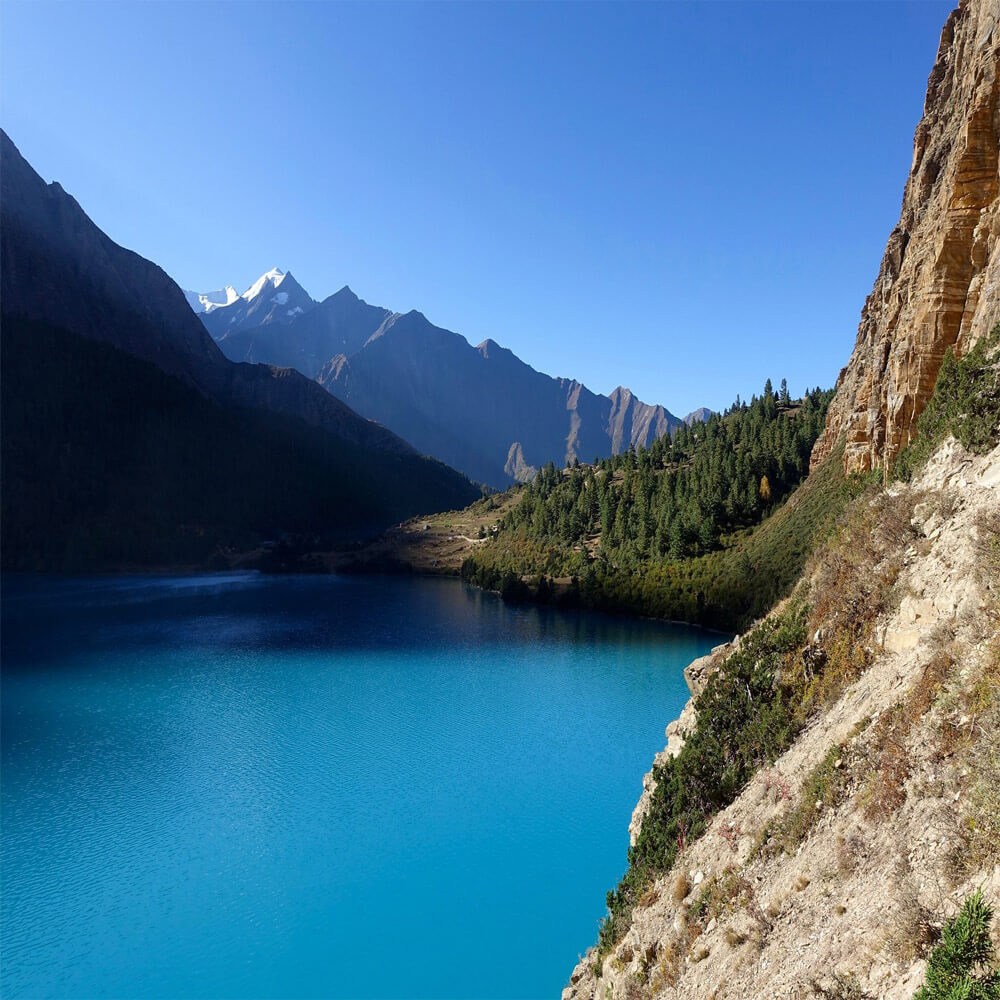
The terrain and elevation are simply two factors in the Lower Dolpo Trek difficulty. Your physical strength and endurance are equally crucial. You must prepare your body before beginning this adventure if you want to have fun and stay safe.
Stamina for Long Walking Days
You will often trek six to eight hours a day, and maybe much longer, on the Lower Dolpo Trek. The trails are not level; they cross rivers, climb and descend hills, and pass through rocky terrain. If you are not accustomed to walking for extended periods of time, this can be exhausting. You can get ready by practicing walking or trekking in your neighborhood, gradually increasing the distance and duration each week. Your legs and lungs will become stronger as a result, allowing you to enjoy the trek without experiencing excessive fatigue.
Strength for Steep Climbs and High Passes
There are difficult climbs in some areas of the Lower Dolpo Trek, particularly as you traverse high mountain passes that can reach elevations of over 5,000 meters. Additionally, you will be carrying your day bag or backpack, which increases the weight. You can strengthen your legs and core muscles prior to the trek to make these climbs easier. Exercises like lunges, squats, and stair climbing can be beneficial. Having strong muscles can help you manage the trail's ups and downs and protect your joints.
Fitness for High Altitude
The Lower Dolpo Trek difficulty is higher because of the altitude. As you ascend, the air grows thinner, which results in less oxygen reaching your body. You may have fatigue, dyspnea, or vertigo as a result. To get ready, strengthen your heart and lungs with regular exercise like swimming, cycling, or jogging. Being physically fit will make it easier for your body to adapt, even if you are unable to train at high elevations. During the trek, it is also critical to take breaks, walk slowly, and stay hydrated.
You may appreciate Lower Dolpo's beauty without feeling overpowered by the difficulty if you prepare yourself properly. Being physically fit makes the trip much more pleasurable, safer, and more comfortable.
Weather and Seasonal Impact on Lower Dolpo Trek Difficulty
Best Seasons to Make the Trek Easier
One of Nepal's wildest and most isolated treks is the Lower Dolpo. A major factor in how difficult or easy the travel feels is the weather. Autumn (September to November) and late spring (April to May) are the ideal seasons to visit. The weather is often moderate during these months, with clear sky. The evenings are cool but not frigid, while the days are nice enough for strolling.
By selecting certain times of year, the Lower Dolpo Trek difficulty decreases significantly. There are no deep snow or heavy rain to cope with, mountain vistas are unobstructed, and the trails are dry and safe to walk on. Because the water level is lower, crossing the river is also simpler. If you travel during these months, you will not have to worry as much about hazardous weather and can concentrate more on taking in the sights, touring villages, and discovering the stunning landscapes.
How Weather Can Make the Trek Harder?
The Lower Dolpo Trek difficulty rises significantly if you decide to travel during the winter months of December through February. During these months, thick snow frequently covers high passes. It becomes really cold, especially at night, and if you are not careful, you could get frostbite. In addition to being slow and exhausting, walking on icy pathways can occasionally result in blocked paths that force you to turn around or take longer routes.
Heavy rains throughout the summer monsoon season (June to August) cause the trails to become muddy and slick. Landslides may obstruct portions of the path, and leeches may be an issue in the lower woodlands. Rain clouds also obscure the stunning mountain vistas, which is one of the primary reasons this trek is so popular.
There are fewer trekkers on the trail during the winter and monsoon seasons, which makes it more peaceful but also riskier. More supplies, better equipment, and a knowledgeable guide who can deal with bad weather are all necessary.
The Lower Dolpo Trek difficulty varies greatly depending on when you travel. Selecting the appropriate season can improve the trip's comfort, safety, and enjoyment. Selecting a challenging season increases adventure but also risk, so make sure you carefully consider your options.
Accessibility and Facilities
There is more to the Lower Dolpo Trek difficulty than just high altitude and hard climbs. The area's extreme remoteness is a major factor in why it feels more difficult. In contrast to Nepal's more well-traveled trekking routes, this implies that there are less amenities and less access to facilities.
Limited Teahouses and Lodges
There are not as many teahouses or guesthouses along the Lower Dolpo trail as there are in the Annapurna or Everest regions. Although they are simple, several villages feature tiny lodges. Beds and blankets may be basic in rooms, and sharing may be necessary at times. There are no teahouses at all in more isolated locations, so camping is the only choice. Because you have to carry more equipment and rely on your own culinary crew, this makes the voyage more difficult.
Food and Water Supply
There are not many food options in Lower Dolpo. Do not expect a menu with lots of selections, though villages may have dal bhat (rice with lentils) and a few other regional foods. You may need to bring extra supplies from the beginning if you have unique dietary requirements. Finding clean drinking water is also more difficult. You ought to have some purification tablets or a water filter with you. Planning your food and water becomes crucial, which increases the Lower Dolpo Trek difficulty.
Camping-Based Trekking
Many trekking groups camp in the forest because teahouses are scarce. Tents, sleeping bags, cooking stoves, fuel, and food are all need for camping. Porters or mules will probably be required to assist with the load. Although camping can be enjoyable, it also adds difficulty to the journey. It takes time and effort to set up and pack camp each day.
Carrying Essentials
The Lower Dolpo region is far from cities, making it difficult to purchase or replace items while traveling. From the beginning, you need to pack all of your essential equipment, medication, and warm clothing. It is challenging to obtain a substitute if anything breaks or disappears. Another factor contributing to the Lower Dolpo Trek Difficulty is the absence of convenient access.
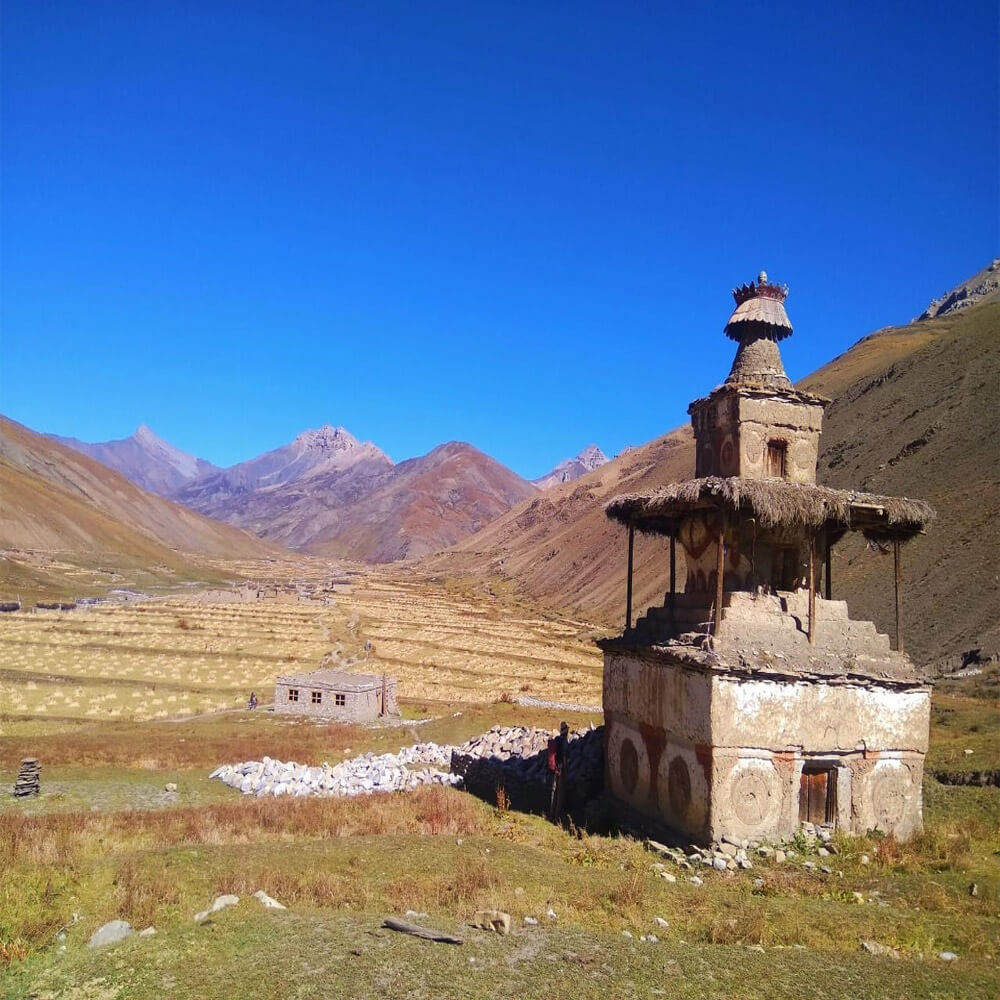
Although the Lower Dolpo trek is breathtaking and full of adventure, there are not as many facilities because of its remote location. You must be ready to live simply, travel great miles between villages, and camp in the wilderness. Because of this, the Lower Dolpo Trek Difficulty is higher than that of many other Nepal treks.
Challenges for Specific Groups on Lower Dolpo Trek
Beginners
For beginners, the Lower Dolpo hiking may be too challenging. The trails can be exhausting, lengthy, and occasionally steep. It is necessary for beginners to train prior to the trek. It is crucial to practice carrying a backpack, walking over difficult terrain, and acclimating to high altitude. Additionally, beginners should take breaks, move carefully, and stay hydrated. The trek can be safer and easier if you hire a guide or porter.
Seniors
The Lower Dolpo Trek may lead to additional challenges for seniors. Older trekkers may find the route exhausting due to its lengthy walking days, steep climbs, and high passes. Seniors should walk more slowly and schedule more days off. Prior to the trek, health examinations are crucial. Warm clothing, trekking poles, and appropriate footwear can facilitate walking. Seniors can safely take in Lower Dolpo's beauty with a little preparation.
Solo Trekkers
It is the Lower Dolpo Trek Difficulty that solo trekkers encounter differently. It can be challenging to walk alone in isolated places if you grow weary or experience bad weather. Teahouses are scarcer, and communication may be difficult. A first-aid kit, maps, and extra food are essential for lone trekkers. Joining a small group or hiring a guide is safer. The trek is safer and more pleasurable when people stay vigilant and monitor the weather every day.
Tips for Everyone
The Lower Dolpo Trek Difficulty requires preparedness regardless of age or experience. Pacing yourself, having the right equipment, and exercising regularly are crucial. You may avoid difficulties by eating enough, drinking enough water, and paying attention to your body. You can also enjoy the walk better if you are mentally prepared for lengthy days and remote locations.
Mental and Emotional Challenges of the Lower Dolpo Trek
The Lower Dolpo Trek Difficulty involves more than just steep passes and long walks. Emotional and mental strength are also crucial. Trekking in isolated places can be physically and mentally taxing.
Feeling Lonely and Isolated
Lower Dolpo has a lot of remote areas from towns and villages. You might walk for hours at a time without seeing anyone. This can be isolating, particularly for trekkers who are going alone. It is crucial to maintain your optimism and take in the surrounding peace and beauty. Speaking with guides or other trekkers can also make you feel less isolated.
Coping with Long Walking Days
Six to eight-hour days are part of the expedition. Walking over extended periods of time can be exhausting and frustrating. If you simply think about how far you still have to travel, it is easy to lose motivation. Instead, appreciate the scenery, celebrate little victories, and go one step at a time. With this method, the Lower Dolpo Trek Difficulty is easier to handle mentally.
Dealing with Uncertain Conditions
Lower Dolpo's weather is subject to sudden changes. Walking becomes more difficult when rivers rise or walkways get slick. It can be distressing to not know what to anticipate. You may manage these situations by remaining composed, being organized, and having faith in your leader.
Staying Motivated
The high passes, historic villages, and isolated landscapes are breathtaking rewards. You can stay motivated by concentrating on the beauty and distinctive experiences. Keep in mind that while the Lower Dolpo Trek Difficulty is challenging, it also provides a memorable sense of accomplishment.
Mental preparedness is just as crucial as physical training. You will appreciate the trek more and deal with its challenges more effectively if you are prepared to be patient, adaptable, and upbeat.
Comparing Lower Dolpo Trek Difficulty with Other Treks
Although the Lower Dolpo Trek is regarded as moderately in difficulty, it differs greatly from other well-known Nepal trekking.
Compared to Annapurna Base Camp Trek
Most trekkers find the Annapurna Base Camp (ABC) Trek to be easier. It is lower in elevation than Lower Dolpo, has many teahouses, and has clearly indicated routes. ABC is less secluded and offers shorter daily walking hours, despite some steep sections. Lower Dolpo, on the other hand, is more remote, has fewer teahouses, and has longer trekking days, all of which make it harder overall.
Compared to Everest Base Camp Trek
The 5,364-meter elevation of Everest Base Camp (EBC) makes the trek physically taxing as well. But the facilities are better and the trail is more popular. Because of the greater remoteness of Lower Dolpo, trekkers must endure longer periods of time without assistance or supplies. This isolation makes the Lower Dolpo Trek more emotionally and mentally taxing.
Compared to Manaslu Circuit Trek
Like Lower Dolpo, the Manaslu Circuit Trek is lengthy and includes high passes. However, it has more communities along the way and is marginally easier to reach. Lower Dolpo is more difficult for people who are not accustomed to isolated trekking because of its rough terrain, river crossings, and lack of lodging.
Overall Comparison
The Lower Dolpo Trek Difficulty is distinct due to its combination of physical effort, elevation, and severe remoteness. Lower Dolpo challenges both physical and mental stamina, yet certain treks, like ABC, are simpler and more supported, while others, like EBC, are higher but easier to reach. Experienced trekkers looking for challenge, isolation, and unspoiled scenery will love it. Trekkers with experience will find it rewarding, but beginners may find it quite difficult.
Conclusion: Lower Dolpo Trek Difficulty
Although the Lower Dolpo trek is challenging, it is breathtakingly beautiful and exciting. You must be physically healthy, able to walk for extended periods of time, and equipped to handle cold temperatures and high alpine terrain. If they practice properly and take their time, beginners can succeed. Elderly people should take particular care, get plenty of relaxation, and focus on their health. Due to the trail's remote location, lone trekkers must carefully plan and exercise caution.
For this journey, Nepal Trekking Routes can be of assistance. We make the trip safer and simpler by providing porters, guides, and all the necessary planning. It is possible to complete a difficult journey like Lower Dolpo with the correct team and planning. All of the effort is worthwhile because of the breathtaking mountains, serene villages, and distinctive culture.
Some of Frequently Asked Question
How hard is the Lower Dolpo trek?
The Lower Dolpo trek is moderate to challenging. It has long walking days, steep climbs, and high passes. Trekkers need good fitness and stamina.
Can beginners do the Lower Dolpo trek?
Beginners can try it with proper training and preparation. Walking slowly, resting often, and following a guide helps make the trek easier.
What fitness level is required?
Trekkers should have good endurance for 5–7 hours of walking each day. Leg strength, balance, and stamina are important, especially for steep and rocky trails.
How does altitude affect the difficulty?
Some parts reach about 5,000 meters. High altitude can cause headaches, dizziness, or nausea. Trekkers must acclimatize properly and drink plenty of water.
Is it safe for solo trekkers and seniors?
Yes, if careful. Seniors should rest often and monitor health. Solo trekkers should plan carefully, use guides, and carry emergency communication tools.




